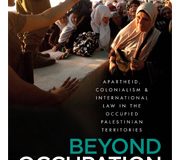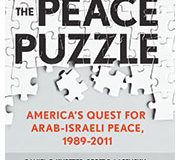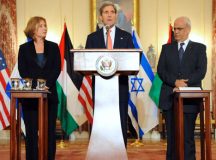The one-state solution is a mirage. Only the two state solution can meet the national aspirations of both peoples. It is time to give common sense its day.
Cast your eye over two decades of attempts to turn the two-state solution into a reality since the Oslo Accords and you are confronted with a bleak picture. Many of the initial enthusiasts have come to favour other solutions or have simply chosen to turn a blind eye to the conflict. Within both political elites, and among the two peoples, there does not seem to be much hope.
But despite all, the two-state solution still has one thing in its favor: common sense. For make no mistake, the last 20 years have not produced any better alternatives, nor have they fulfilled the desires of two-state rejectionists. And when we look at the regional picture, it becomes clear that the two-state solution still benefits all neighbours. Moreover, the opportunities for both peoples that the two-state solution offers remain as huge as ever; most obviously, it guarantees the right to national self-determination of both peoples.
It is clear that Israel is not in favor of a bi-national state. The status quo has been, and continues to be, rejected by the world and the occupation affects Israel’s standing among nations and the Jewish Diaspora. And with all its consequences, the occupation does not comply with the great values of Judaism.
The status-quo can also not continue for Palestinians either; not only because of the hardships and injustices of living under occupation, but because of the lost opportunities for producing a more enlightened, skillful and ambitious generation that is capable of shaping the future Palestinian state as we would like to see it. Our rejection of a bi-national state was declared with our pursuit of statehood after Oslo. For let us not forget the peaceful circumstances that existed between Palestinians and Israeli up until the nineties and why they came to an end: they did not fulfill Palestinian national aspirations and other demands, such as the right of return among others, hence the two-state solution – it was the common sense approach.
But common sense has had a hard time of it. For Israel, it’s hard to understand how the interests of around 500,000 settlers can outweigh the deepest needs of the state and of the Jewish Diaspora, even in the face of a renewed Arab peace initiative that could guarantee normal relations in the region. Of course, it is not easy; the current instability in the Arab world and the disappointing outcomes so far of the Arab Spring makes it understandable that Israel finds it difficult to make peace with an Arab world that cannot seem to make peace with itself.
Common sense should dictate that Arabs look hard at Israel’s record-breaking success in building a modern nation that competes at the highest levels of productivity and development. This should be something that Arab states can use to respond to the demands of the eager youth leading revolutions across the region. In fact, the resources available to the Arab nations mixed with Israel’s drive for prosperity and its experience in creating fertile start-up environments, should be the perfect formula; the entire Middle East would look very different under conditions of cooperation – a new regional start up of a unique kind!
Common sense should also guide our attempts to resolve final status issues. The logic of the ‘land for peace’ formula should remain the basis for resolving the conflict, and yet, standing on the land to be traded to the Palestinians are settlements preventing an agreement on future borders. Israel claims that settlements are not the problem, but if you ask yourself why the occupation exists with all its features – closures, checkpoints, separation wall – you will find it is entirely for the preservation of settlements; their security and the provision of space for them to expand. Hence, while actual settlement building is on only two per cent of the West Bank, they control over 40 per cent of the entire land designated for a future Palestinian state.
The history of the settlements growth illustrates the threat they pose to a two-state solution. After the Six-Day War in 1967, when Israel became the occupying power in the West Bank and the Gaza Strip, several plans to build settlements were proposed by different Israeli leaders; all were explicitly aimed at preventing the existence of an Arab state. The architects of these plans executed their plans rapidly so as to create such a large settlement presence; their hope was that if any future Israeli government decided to concede the land for peace through the creation of an Arab state, it would have to face an Israeli civil war.
Among the first architects of the Israeli settlement plan was Matityahu Drobless, at the time Co-Chair of the World Zionist Organization’s Settlement Department, who stated: ‘There must not be the slightest doubt regarding our intention to hold the areas of Judea and Samaria for ever … [t]he best and most effective way to remove any shred of doubt regarding our intention to hold Judea and Samaria forever is a rapid settlement drive in these areas.’ (see The Settlement in Judea and Samaria – Strategy, Policy and Program [in Hebrew] World Zionist Organization, 1980, p. 3.). Another architect of the settlement plan, Ariel Sharon when Minister of Agriculture and Land, believed that ‘it was important to prevent the creation of a contiguous area populated by Arabs on either side of the Green Line, leading to the connection of the area west of Jenin and Nablus, and north of Ramallah, to the Palestinian communities within Israel adjacent to the Green Line, such as Umm el-Fahm and Kafr Qasem.’ (see Geoffrey Aronson, Creating Facts: Israel, Palestinians and the West Bank, 1987, p. 71.)
While the official Israeli position is that security demanded the introduction of settlements, those same settlements are today a central reason for Israel’s security quandaries. They are the reason why Israel remains without internationally recognised borders, even by its closest allies. While the existence of long range missiles means there is very little that settlements can do to guarantee Israel’s security in the future, what settlements have been very successful in doing so far is fulfilling their planners’ vision of preventing the establishment of a Palestinian state.
Reaching an agreement in the early nineties with less than half the existing settlements was less complicated. Both sides are now striving once more to negotiate a two-state solution, but the settlements still expand. The question one has to ask is: why? Both Israelis and Palestinians know what they want and dream of the same brighter future. Our greatest untapped asset remains: common sense. It is time to give it its day.






































Perhaps the writer should consider what happened when Israel withdrew its settlements from Gaza; instead of reacting to Israel’s positive action in withdrawing, it led to extensive rocket attacks on Israel leading to two defensive wars. While Egypt locked its border with Gaza, it was the ‘Israeli enemy’ who did and still does supply Gaza with electricity, oil and building materials (including the cement that should have been used for rebuilding but instead was utilised to line the tunnels intended to allow incursions into Israel. Combining those actions with Hamas’s constant reiteration that ‘all Palestine will be free, from the river to the sea’ suggests that a two state solution is not wanted by the Arabs except as a first step to destroy Israel.
So setting up yet another homophobic misogynistic Muslim majority tyranny whose hall marks will be gender discrimination against females, religious intolerance toward all non-Muslim faiths, persecution of homosexuals, and prosecution of political dissidents is your idea of “common sense”.
Why would you expect a prospective Palestinian state to be anything else?
You write: “…new regional start up of a unique kind” Really? Shades of the discredited “New Middle East”?
BTW why is no such initiative even vaguely apparent in the Arab world today? Too much “Arab Spring”?